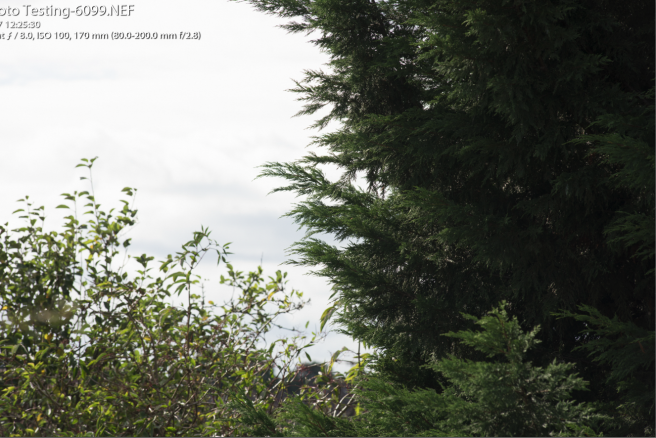Classification of various systems between linear and complex systems with tight and loose coupling.


Classification of various systems between linear and complex systems with tight and loose coupling.

Both lenses:

Lets see the F2.8 lens first, shooting a tree in the garden at 200mm, F8, cropped image below:


Now at F4:


And finally wide open at F2.8:


Looks pretty good, very little chromatic abberation.
Now moving onto the 70-210 F4 lens, at 210mm, F8:


The colours are not as punchy as the F2.8 lens. Now lets go wide open at F4:


Significant loss of resolution.
Now lets try a harsher test: Trees with white sky behind it for chromatic abberation. Again, beginning with the F2.8, this time at 170mm, at F8:


Pretty good. Now at F5:


A bit of focus error, yet the in focus parts still holding up well. Finally wide open at F2.8:


Finally see a bit of chromatic abberation. Still acceptable as it is a very harsh test.
Now moving onto the F4 lens at 210, starting with F8:


Hmm, sort of acceptable, but it should be better than this at F8. Now at F4:


Significant chromatic abberation!
However, the F4 is £150 or even cheaper on ebay. The F2.8 is ~£300-350+. You get what you pay for. Also the F2.8 is significantly heavier, so it is quite cumbersome to carry around. The F4 is a delight to use for street shooting at F8, and convenient to carry around.
A comparison of the image quality of the iPhone 6 versus the iPhone 7, of the same scene captured in the office. The iPhone 7 has slightly more noise, which is expected form the smaller pixel size, and appears to be less vivid than the iPhone 6. However it wins with respect to resolution quite clearly. See images below, with some analysis done in Image J.

Above zoomed image highlighting the lower noise on the left of the iPhone 6 versus the iPhone 7 on the right.

More vivid colours of the iPhone 6 on the left versus the iPhone 7, yet better definition of the plants on the right.
“Yet since 2013, an astonishing number of voices have been heard in favour of a flexible currency regime, one that could enable democratic politics to even out imbalances through less destructive means than internal devaluations. The suggestions made range from a return to national currencies, via the temporary or permanent introduction of parallel currencies, together with capital controls, right through to a Keynesian two-tier currency system.37 No nostalgia for the Deutschmark’ is required to see the urgent need for joint reflection on the reconstruction of the European single currency, in a way that might be beneficial for Europe, democracy and society. In principle, this theme might also emerge from the no less urgent search for a better global monetary system than exists at present – one that has become increasingly dysfunctional since
the definitive dismantling of the Bretton Woods regime in the early 19705, and almost brought the world economy to the point of collapse in 2008. The failure of the euro is just one development among many to dispel the illusion that arose from the anomalously peaceful conditions of the post-war
period – the conviction that what money is and how it should be managed is a question that has been settled once and for all. Debates about a new global monetary and financial regime are now well overdue. Their task will be to devise a system flexible enough to do justice to the conditions and constraints governing the development of all societies participating in the world economy without encouraging rival devaluations, or the competitive production of moneu or debt, together with the geostrategic contests they foster. Agenda items would include the successor to the dollar as a reserve currency, the empowerment of states and international organizations to set limits to the
free movement of capital, regulation of the havoc caused by the shadow banks and the global creation of money and credit, as well as the introduction affixed but adjustable exchange rates. Such debates could take their cue from the astonishing wealth of ideas about alternative national and supranational monetary regimes produced in the interwar years by such writers as Fisher or Keynes. They would teach us at the very least that money is a constantly developing historical institution that requires continual reshaping, and must be judged as efficient not just in theory but also in its political
function. The future of the European single currency could in that way become a subordinate theme of a worldwide debate about a monetary and credit system for capitalism – perhaps even for a post-capitalist order of the twenty-first century.
Or not, as the case may be. Now more than ever there is a grotesque gap between capitalisms intensifying reproduction problems and the collective energy needed to resolve them – affecting not just the necessary repairs to the monetary system, but also regulation of the exploitation oflabour-power and the environment. This may mean that there is no guarantee that the people who have been so kind as to present us with the euro will be able to protect us
from its consequences, or will even make a serious attempt to do so. The sorcerer s apprentices will be unable to let go of the broom with which they aimed to cleanse Europe of its pre-modern social and anti-capitalist foibles, for the sake of a neoliberal transformation of its capitalism. The most plausible scenario for the Europe of the near and not-so-near future is one of growing economic disparities – and of increasing political and cultural hostility between its peoples, as they find themselves flanked by technocratic attempts to undermine democracy on the one side, and the rise of new nationalist parties on the other. These will seize the opportunity to declare themselves the authentic champions of the growing number of so-called losers of modernization, who feel they have been abandoned by a social democracy that has embraced the market and globalization. Furthermore, this world, which lives under the constant threat of possible repetitions of 2oo8, will be especially uncomfortable for the Germans, who for the sake of the euro will find themselves having to survive without the ‘Europe to which they had once looked to provide them with a safe dwelling place, surrounded by well-disposed neighbours.”
Wolfgang Streeck, How Will Capitalism End? Verso, 2016
“Capitalism, that is to say, is indeed always embedded in that it takes place in a society, subject to social constraints and opportunities. Also, capitalism in an important sense depends on remaining so embedded as it thrives on the rule of law, mutual trust, normative coordination and institutionalized cooperation, creative intelligence and the like. Nevertheless, and at the same time, capitalist actors always struggle to escape from their social containment and free themselves from obligations and controls. Ideas of solidarity and
institutions of social regulation are as a result at a permanent risk of erosion, with capitalist patterns of action spreading like cancer in the body social even though capitalism as such, pure and simple and liberated from social constraints, cannot exist. In this sense capitalism feeds parasitically on the society that it inhabits or befalls, with its expansion ultimately amounting to its self-destruction unless checked by social and political opposition.
Sometimes, as in the neoliberal era, the capitalist advance may capture the very politics that should contain it for its own good, and turn it into a vehicle of its own self-destructive progress; this, I believe, is what Polanyi meant when he described the expansion of ‘market society’ as a ‘frivolous experiment’ of states and governments.”
Wolfgang Streeck – How Will Capitalism End? (2016)
“The fools, who do not understand that actual rank does not matter at all and that he who occupies the top very rarely plays the chief role. How often a king is ruled by a minister; how many ministers by their secretaries! And who is then the first? I believe it is the man who knows his fellowmen at a glance and has sufficient power or shrewdness to harness their forces and passions to the execution of his plans.”
The principal mark of sovereign majesty and absolute power is essentially the right to impose laws on subjects generally without their consent….There is indeed a distinction between justice and law, for one merely implies equity, while the other implies command. Law is nothing other than command of the sovereign in the excercise of his power.
“The key to hiding this central mechanism lay in the very structure of the capitalist world-economy, the seeming separation in the capitalist world-system of the economic arena (a world-wide social division of labour with integrated production processes all operating for the endless accumulation of capital) and the political arena (consisting ostensibly of separate sovereign states, each with autonomous responsibility for political decisions within its jurisdiction, and each disposing of armed forces to sustain its authority). In the real world of historical capitalism, almost all commodity chains of any importance have traversed these state frontiers. This is not a recent innovation. It has been true from the very beginning of historical capitalism. Moreover, the transnationality of commodify chains is as descriptively true of the sixteenth-century capitalist world as of the twentieth-century.
How did this unequal exchange work? Starting with any real differential in the market, occurring because of either the (temporary) scarcity of a complex production process, or artificial scarcities created manu militan, commodities moved between zones in such a way that the area with the less ‘scarce
item ‘sold’ its items to the other area at a price that incarnated more real input (cost) than an equally-priced item moving in the opposite direction. What really happened is that there was a transfer of part of the total profit (or surplus) being produced from one zone to another. Such a relationship is that of coreness-peripherality. By extension, we can call the losing zone, a ‘periphery’ and the gaining zone a ‘core’. These names in fact reflect the geographical structure of the economic flows.
We findunmediately several mechanisms that historically have increased the disparity. Whenever a ‘vertical integrationof any two links on a commodity chain occurred, it was possible to shift an even larger segment of the total surplus towards the core than had previously been possible. Also, the shift of surplus towards the core concentrated capital there and made available disproportionate funds for further mechanization, both allowing producers in core zones to gain additional competitive advantages in existing products and permitting them to create ever new rare products with which to renew theprocess. The concentration of capital in core zones created both the fiscal base and the political motivation to create relatively strong state-machineries, among whose many capacities was that of ensuring that the state machineries of peripheral zones became or remained relatively weaker. They could therebypressure these state-structures to accept, even promote, greater specialization in their jurisdiction in tasks lower down the.,hlrerarchy ,of commodity chains, utilizing lower-paid work-forces and creating (reinforcing) the relevant houTehoİd structures to permit such work-forces to survive. Thus did
historical capitalism actually create the so-called historical level of wages which have become so dramatically divergent in different zones of the world-system.”
Historical Capitalism, Immanuel Wallerstein, pg. 31-32, 2011, Verso.
Notes from the Underground, F Dostoevsky, Oxford Classics, 1999.
I, for instance, quite naturally want to live in order to satisfy the whole of my for living and not just in order to satisfy my rational capacity, which is about one-twentieth of my capacity for living. What does reason know? Reason knows only what it has managed to find out (the rest, perhaps, it will never discover; that’s no comfort, but why not say it?), whereas
human nature acts as a whole, by everything that is in it, consciously and unconsciously; and even if it lies, it still lives. I suspect, gentlemen, that you’re looking at me with pity, you will tell me again that an enlightened and educated person, in short, the sort of person man will be in the future, cannot
knowingly desire something disadvantageous to himself, and that’s mathematics. I’m in complete agreement, it really is mathematics. But I repeat to you for the hundredth time, there is only one instance, just one, when man may deliberately, consciously desire something injurious, foolish, even extremely foolish, namely: in order to have the right to desire even something very foolish, and not to be bound by an obligation to desire only what is intelligent. You see, this very foolish thing is your caprice, and in actual fact, gentlemen, it can be more advantageous to us all than anything else on earth, especially on certain occasions. But in particular it can be more advantageous than any other advantage in a situation where it leads us to obvious harm and contradicts the soundest conclusions of our reason on the subject of advantages—because in any case it preserves the thing that is most important and
precious to us, which is our personality and our individuality. Some people assert that this is the most precious thing of all to man. Desire may, of course, if it wants, coincide with reason, especially if it is not misused but used in moderation; that’s useful and at times even laudable. But very often, perhaps more often than not, desire completely and obstinately disagrees with reason and. . .and. .. and do you know that this too is useful and sometimes even very laudable?
Swiss Railways from Diccon Bewes book, Swiss Watching:
“Gravity-detying mountain trains might be the most famous part of the Swiss railway network, but they actually make up only 150 of the 5000 kilometres of lines nationally. Trains are the workhorses of the Swiss economy, transporting not just tourists and commuters but cargo as well. An impressive 63 per cent of transalpine heavy goods vehicles travel by rail through Switzerland, twice as much as in neighbouring Austria.Loading those mammoth trucks on to trains means less pollution, less traffic and less noise, so everyone wins. But the wonder of the Swiss railway system is not the cargo routes through the mountains, or the big-name rides, such as
the Glacier Express, or even the intercity lines packed with the customers. The wonder of the Swiss transport network is the local services.
Decades after Dr Beeching cut such lines in Britain, the Swiss still regard them as an essential part of the national infrastructure, no matter if they aren’t so well used. The crowded routes bring in the cash to subsidise the less-used ones so that the whole network survives. All very forwardthinking, anti-Darwinian and anti-capitalist to someone brought up on privatisation for profit. For the Swiss it’s local services for local people, and occasionally the odd tourist, to ensure that no community is left off the transport map. To achieve that goal there are buses as well, designed to complement the railways, not replace them. A spidery network of 798 routes with over 2100 Postbuses, all of them bright yellow, carries 121 million passengers a year11 to places the trains can’t reach. But, this being Switzerland, the timetables are coordinated, so that passengers can change quickly from train to bus and back again. The Swiss make it all look so simpie, as if that’s the natural order of things. As if that’s the only way public transport should be. Such coordination is only possible because the Swiss plan the whole system as one.”